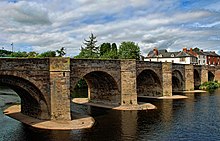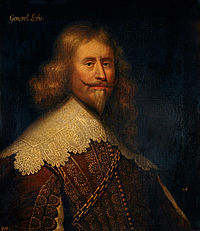Siege of Hereford
| Siege of Hereford | |||||||
|---|---|---|---|---|---|---|---|
| Part of the First English Civil War | |||||||
 The Bridge over the River Wye was the scene of heavy fighting during the siege. | |||||||
| |||||||
| Belligerents | |||||||
|
|
| ||||||
| Commanders and leaders | |||||||
|
| |||||||
| Strength | |||||||
| 1,500 | 14,000 | ||||||
| Casualties and losses | |||||||
| Unknown | Unknown | ||||||
The siege of Hereford took place in 1645 during the
Background
Hereford and the
In 1645 the tide of the war turned decisively against
Siege

Leven's advance into Herefordshire brought him into conflict with the fortified manor house at Canon Frome near Ledbury, commanded by Colonel Sir John Barnard. After the Scottish forces stormed the place they massacred many of the defenders and executed Barnard.[5] On reaching Hereford, Leven had around 14,000 troops under his command while Scudamore had 1,500 defenders. After an initial fight around the bridge over the River Wye, Leven offered terms to Scudamore but he rejected them as he could not surrender without the king's permission. Scudamore still hoped to receive relief from Charles in Wales. Leven kept very strict discipline amongst his men regarding looting.[6]
Several major assaults were attempted on the city and in one of them, the Scottish
Charles had gathered some fresh troops and was advancing slowly to assist the garrison at Hereford. More alarmingly for Leven came news of the victory for the Scottish Royalists and their allied
Aftermath
Within less than two weeks the Covenanters had won a striking victory over Montrose at the
The events of the siege were portrayed in Daniel Defoe's 1720 novel Memoirs of a Cavalier which was written from the point of view of one of the Royalist participants.
Fall of Hereford
In December Parliamentary forces under
References
Bibliography
- Bennett, Martyn. Historical Dictionary of the British and Irish Civil Wars 1637–1660. Rowman & Littlefield, 2016.
- Grosjean, Alexia & Murdoch, Steve. Alexander Leslie and the Scottish Generals of the Thirty Years' War, 1618–1648. Routledge, 2015.
- Hopper, Andre. Turncoats and Renegadoes: Changing Sides During the English Civil Wars. Oxford University Press, 2012.
- Hutton, Ronald. The Royalist War Effort: 1642–1646. Routledge, 2003. Scarecrow Press, 2004.
- McRae, Alisdair. How the Scots Won the English Civil War: The Triumph of Fraser's Dragoons. The History Press, 2013.
- Manganiello, Stephen C. The Concise Encyclopedia of the Revolutions and Wars of England, Scotland, and Ireland, 1639–1660.
- Newman, P.R. Atlas of the English Civil War. Routledge, 2005.
- Reese, Peter. Cromwell's Masterstroke: Dunbar 1650. Pen and Sword, 2006.
- Rogers, Pat. The Life and Times of Thomas, Lord Coningsby: The Whig Hangman and His Victims. A&C Black, 2011.
- Stoyle, Mark. Soldiers and Strangers: An Ethnic History of the English Civil War. Yale University Press, 2005.
- Wilcher, Robert. Keeping the Ancient Way: Aspects of the Life and Work of Henry Vaughan (1621–1695). Oxford University Press, 2021.
